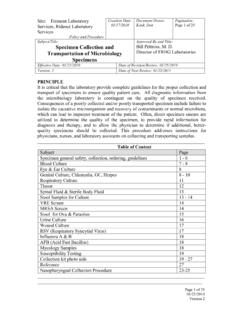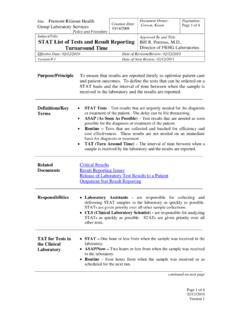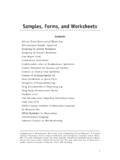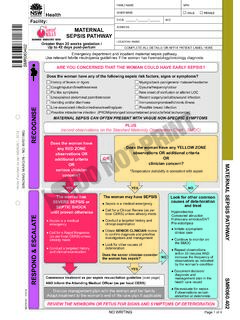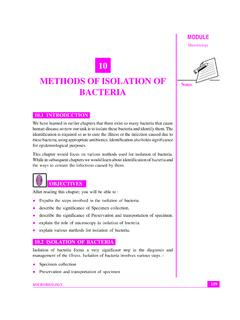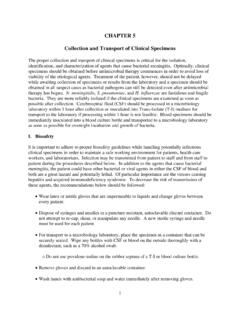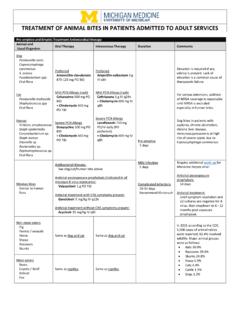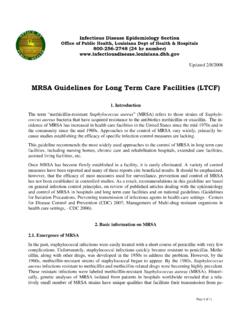Transcription of Specimen Collection and Transportation of Microbiology ...
1 Site: Fremont Laboratory Services, Rideout Laboratory Services Policy and Procedure Creation Date: 01/17/2010 Document Owner: Kauk, Don Pagination: Page 1 of 25 Subject/Title: Specimen Collection and Transportation of Microbiology Specimens Approved By and Title: Bill Pettross, M. D. Director of FRHG Laboratories Effective Date: 01/25/2010 Date of Revision/Review: 01/25/2010 Version: 2 Date of Next Review: 01/25/2011 Page 1 of 25 01/25/2010 Version 2 PRINCIPLE It is critical that the laboratory provide complete guidelines for the proper Collection and transport of specimens to ensure quality patient care.
2 All diagnostic information from the Microbiology laboratory is contingent on the quality of Specimen received. Consequences of a poorly collected and/or poorly transported Specimen include failure to isolate the causative microorganism and recovery of contaminants or normal microbiota, which can lead to improper treatment of the patient. Often, direct Specimen smears are utilized to determine the quality of the Specimen , to provide rapid information for diagnosis and therapy, and to allow the physician to determine if additional, better-quality specimens should be collected.
3 This procedure addresses instructions for physicians, nurses, and laboratory assistants on collecting and transporting samples. _____ Table of Content Subject Page Specimen general safety, Collection , ordering, guidelines 1 - 6 Blood culture 7 - 8 Eye & Ear culture 8 Genital culture , Chlamydia, GC, Herpes 8 - 10 Respiratory culture 11 Throat 12 Spinal Fluid & Sterile Body Fluid 13 Stool Samples for culture 13 - 14 VRE Screen 14 MRSA Screen 14 Stool for Ova & Parasites 15 Urine culture 16 Wound culture 17 RSV (Respiratory Syncytial Virus)
4 17 Influenza A & B 18 AFB (Acid Fast Bacillus) 18 Mycology Samples 18 Susceptibility Testing 19 Collection kit photo aids 19 - 27 Reference 27 Nasopharyngeal Collection Procedure 23-25 _____ Specimen Collection and Transportation of Microbiology Specimens Date & Time Viewed: 12/14/2010 at 11:54:42 AM Page 2 of 25 01/25/2010 Version 2 Specimen 1. Specimen Safety considerations a. Follow universal precaution guidelines. Treat all specimens as potentially bio-hazardous. b. Laboratory workers should use appropriate barrier protection (such as gloves and laboratory coat or gown) when collecting or handling specimens.
5 If splashing may occur, protective eyewear, face masks, and aprons may be necessary. c. Do not contaminate the external surface of the Collection container and/or its accompanying paperwork. d. Minimize direct handling of specimens in transit from the patient to the laboratory. Use plastic sealable bags with a separate pouch for the laboratory requisition orders or transport carriers (for example, small buckets with rigid handles). NOTE: Specimens obtained by a physician using needle aspiration should be transferred to a sterile tube or anaerobic transport vial prior to transport of the Specimen to the laboratory.
6 If there is little material in the syringe, the physician should draw a small amount of sterile nonbacteriostatic NaCl or sterile broth through the syringe and then transfer the Specimen to a sterile tube. Alternatively, and only if the Specimen will be compromised by transferring it from the syringe, a small amount of sterile NaCl or broth may be drawn into a syringe prior to removal of the needle. The physician should use a protective device while removing the needle to avoid injury and should cap the syringe with a sterile cap prior to transporting it to the laboratory.
7 2. General guidelines for proper Specimen Collection a. Collect Specimen before administering antimicrobial agents when possible. b. Collect Specimen with as little contamination from indigenous microbiota as possible to ensure that the sample will be representative of the infected site. c. Utilize appropriate Collection devices. Use sterile equipment and aseptic technique to collect specimens to prevent introduction of microorganisms during invasive procedures. d. Clearly label the Specimen container with the patient s name and identification number or date of birth (DOB).
8 Always include date and time of Collection and your initials. LINK e. Collect an adequate amount of Specimen . Inadequate amounts of Specimen may yield false-negative results. LINK f. Develop an understanding of the Microbiology laboratory s source identification schemes. Know when to include rule-out request. For example, the laboratory may routinely screen for Shigella, Salmonella, and Campylobacter species in stool cultures but not for Yersinia or Vibrio species. g. Consider geographic location and season when notifying the laboratory of rule-out requests.
9 For example, Coccidioides immitis is endemic in the southwestern United States, and rotaviruses are more commonly found in infants and children in winter. h. Identify the Specimen source and/or specific site correctly so that proper culture media will be selected during processing the laboratory. Specimen Collection and Transportation of Microbiology Specimens Date & Time Viewed: 12/14/2010 at 11:54:42 AM Page 3 of 25 01/25/2010 Version 2 i. If a Specimen is to be collected through intact skin, cleanse the skin first.
10 For example, use 70% alcohol followed by iodine solution (1 to 2% tincture of iodine or 10% solution of povidone-iodine). Prevent burn by tincture of iodine by removing excess after Specimen has been collected. j. Before Collection the Specimen , consider the risk/benefit ration of the Collection procedure to the patient. k. Collect specimens in sturdy, sterile, screw-cap, leak proof containers with lids that do not create an aerosol when opened. 3. General guidelines for proper Specimen transport a.
